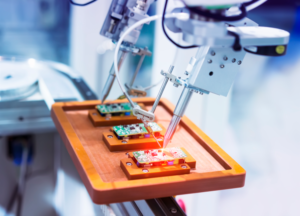PCB Corrosion Causes
2022-12-12
Corrosion is one of the main enemies of printed circuit boards. Why does the circuit board corrode? What are the causes of PCB corrosion?
This article will lead you to understand some of the causes of PCB corrosion and prevention measures.
What is PCB corrosion?
When we talk about corrosion, it’s the oxidation of a metal in contact with air that leads to rust, and eventually the metal loses its chemical properties. Because printed circuit boards are mainly made of metal and are constantly exposed to air, corrosion is inevitable.
Of course, different metals have different resistance to corrosion.
Among them, highly corrosion resistant metals include: gold, silver, copper-nickel alloys, etc. Easy to corrode metal are: tin plating, copper plating, nickel plating, lead and so on.
What are the causes of PCB corrosion?
There are many reasons for metal corrosion in circuit boards:
Air corrosion
This is the most common cause of corrosion. When a metal is exposed to oxygen, it causes metal ions to combine with oxygen atoms and produce oxides. Copper is prone to oxidation. Although the corroded copper retains its mechanical properties, its electrical conductivity is weakened.
Electric couple
Galvanic corrosion occurs when the metal is present in an electrolyte. In fact, the corrosion-resistant metal will corrode faster than the corrosion-prone metal. For example, when gold comes into contact with tin, gold corrodes faster than tin.
Electrolysis
When ion-contaminated moisture affects the voltage between them, adjacent tracks experience dendrite growth, which produces metal fragments that cause short circuits.
Fretting corrosion
In this case, the action of turning off the solder plating switch produces a wiping action that removes the surface oxide layer and thus oxidizes the layer below. Eventually, too much rust can build up and prevent the switch from turning on.
How to clean up corrosion?
You can use a variety of tools to clean PCBs, but some are best for removing corrosion. Cleaning corroded circuit boards involves the following materials:
- Baking soda: Baking soda’s alkaline and abrasive nature makes it the perfect cleanser for corroding PCBs.
- Deionized water: When you clean the circuit board with water, you must make sure it is free of contaminants.
- Household Cleaners: Phosphate-free household cleaners can help you effectively remove dirt and corrosion. Phosphates protect PCBs from corrosion, but they are also a major source of water pollution.
- Soft brush: The soft brush will not scratch the precision components of the circuit board.
- Oven: Make sure the oven is turned off before placing the circuit board in the oven.
Effective measures to prevent PCB corrosion
The primary goal of preventing PCB corrosion should be to avoid ion contamination. The main cause of corrosion of PCBs is exposure of circuit board components to moisture with ion contamination. Your first priority should always be to keep the printed circuit board and its components clean and dry.
Manufacturers should avoid leaving fingerprints or liquids on printed circuit boards and ensure that the boards are manufactured in a clean, dry environment.
If you are designing applications that are exposed to liquid contaminants (e.g. automotive vehicle, industrial, agricultural, etc.), you should take steps to protect your circuit boards from liquid contaminants and the environmental hazards they may face.
To sum up
It is not difficult to keep your PCB clean and dry enough to prevent corrosion. Taking these precautions does not guarantee that your printed circuit board will never corrode, but it can greatly reduce the likelihood of corrosion and effectively extend the life of your product.
To learn more about preventing corrosion on printed circuit boards, contact KingPCB now for our quality assurance approach to manufacturing PCBs.



